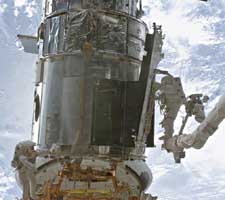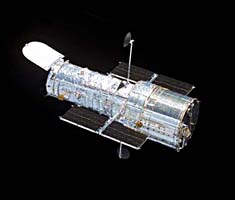
Space-walker John Grunsfeld struggles to attach a radiator panel for the Near Infrared Camera and Multi-Object Spectrograph, or NICMOS, to handrails on the side of the Hubble Space Telescope. Crewmate Rick Linnehan floats at lower left.
Courtesy NASA.
Space walk number 5, on Friday, March 8th, had Rick Linnehan and myself going outside for our third trip, to install the NICMOS cooling system. NICMOS is the infrared camera on Hubble. Observations in infrared light allow astronomers to look through dust, and also to look very far back into the early universe. On space walk 2, Jim Newman and Mike Massimino had installed the electronic control module for the cooling system, and on space walk 5 Rick and I were to install the radiator and cryogenic cooler.
Going out of the hatch it almost seemed as if we were doing a normal activity. In reality we were stepping out into the vacuum of space, insulated by only a few layers of coated cloth and our helmets. The space suits we wear are really remarkable space ships. Each suit has its own pressure vessel, oxygen system, carbon dioxide scrubber, communication system, computer, cooling/heating system, and even a television camera and lights on the helmet. The suit also has a drink bag that we use to get water during the space walks. One difference between our spacesuit and the shuttle is that there is no toilet — we wear "maximum absorbance garments" (diapers), just in case.
Rick and I opened the aft shroud door to get access to NICMOS. I felt like we were opening the doors to a sacred shrine, going inside the area where the scientific instruments on Hubble live. In our training we were taught to have the utmost respect for the delicacy of the instruments, and to treat them with kid gloves, giving some support to the idea of the inside of Hubble as a shrine. Inside the aft shroud I tried to move as carefully as I could, even though I was in the bulky and clumsy space suit. The interior of the telescope is as clean and pristine as it was when launched, maybe more so after years of outgassing in the vacuum of space.
After removing a serpentine vent hose that was originally used for venting gas from the old solid nitrogen cooler on NICMOS, we installed the cryogenic cooler itself. This box, filled with electronics, plumbing, and a tiny turbine that spins at 450,000 rpm, went in smoothly. It looked a bit odd to take the pristine, almost spartan interior of Hubble and add a box covered with cables, hoses, and valves.
Next we got the 3-foot by 12-foot radiator off a carrier in the aft end of Columbia's payload bay and tried to install it on the Hubble. It wouldn't go on. We pushed and pushed, but try as we could, it didn't seem to line up. Rick and I took it off of Hubble and realigned it by moving the latches a bit. This time the alignment looked good, but still we couldn't push it on. With some significant effort Rick got his end of the radiator attached to a handrail, and while poised on the robotic arm of Columbia I took one latch at a time and pressed into the telescope as hard as I could. After a couple of tries at my maximum effort I squeezed the first, then the second latch onto the handrails of Hubble. A small success.
Finally I took a conduit and rotated it down to Rick, poised underneath the telescope. After that, Nancy Currie took me into the aft shroud again over a hole in the bottom of the telescope that was opened up by the vent line removal. I put a couple of tethers together and tried to send the lines through the hole for Rick to catch. I felt as if I was ice fishing, though I could actually see Rick through the hole. He caught the tether, attached it to a long set of cables and cooling lines, and I pulled it through the hole right into where the science instruments live. It was like a giant boa constrictor, and stiff, much stiffer than we had seen in training. Rick joined me and we began the process of hooking up the electronics connectors and the ammonia cooling line to the cryogenic cooler. Inside the cooler is the neon cooling system driven by the small turbine. The supercooled neon is used to cool the detectors on NICMOS to near 70 degrees above absolute zero.
Finally we closed the door and cleaned up the payload bay of Columbia for the last time. As part of that activity I got to ride on the robotic arm, just holding on with my hand high above the payload bay. What a view I had: Columbia below, the bright blue Earth above, and the Hubble Space Telescope at my side. It seemed as if time was standing still, it was so touching a moment for me. My last activity was to remove a protective cover from an antenna on the bottom of the telescope.

The Hubble Space Telescope floats against the blackness of space after astronauts aboard the shuttle Columbia completed five days of repairs and upgrades. The observatory's new rigid solar-cell arrays are shorter but more powerful than the older flexible ones.
Courtesy NASA.
At the end of five space walks to improve the telescope, I gave Hubble a final small tap goodbye, and wished it well on its journey of discovery. It is likely I will never see the Hubble Space Telescope again, but I have been touched by its magic and changed forever.
On Saturday, March 9th, we deployed the telescope back to Earth orbit, and while elated that we finished our work, with all the planned upgrades completed, I did feel a twinge of sadness — the same kind of feeling one gets when saying good-bye to a close friend you won't see for a long time.
 0
0
Comments
You must be logged in to post a comment.